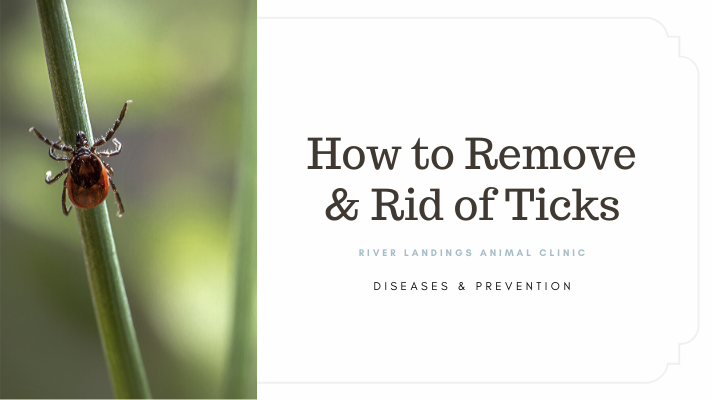Ticks can transmit deadly diseases to a pet within as little as 24 hours of latching on, so swift removal is important for minimizing their exposure to disease.
While removing a tick may seem like a self-explanatory process, you’ve probably heard some myths about tick removal that can actually do more harm to your pet. Here’s the best way to remove a tick from a dog or cat safely.
What You’ll Need to Remove Ticks on Pets
Before you start the actual removal process, these are the supplies you should have on hand:
Tweezers (pointy ones work best)
Latex or rubber gloves
Rubbing alcohol
Antiseptic wipes (optional)
Jar or container with lid
Treats (for distraction)
How to Get a Tick Off Your Pet
Follow these steps to safely remove a tick from your dog or cat:
STEP 1: PUT ON YOUR GLOVES.
Ticks carry infectious agents that can affect both humans and dogs, so it’s always better to play it safe and wear protective gear.
STEP 2: STEADY YOUR PET AND KEEP THEM CALM.
When you’re getting ready to remove the tick, you’ve got to keep your pet calm. Any unusual poking or prodding tends to make dogs and cats nervous. If there is another person available, have that person help keep your dog relaxed during removal.
You may find it helpful to distract your pet with lickable dog treats. You may also use treats as rewards for cooperative behavior during the tick-removal process.
Never try to force your dog or cat to stay put. If your dog resists during the tick-removal process or becomes scared or aggressive, you should enlist the help of your veterinarian.
STEP 3: POSITION YOUR TWEEZERS.
Take a pair of tweezers—fine-tipped, pointy ones work best—and grasp onto the tick as close to your dog’s skin as possible. Grabbing close to the skin is the best way to get a tick head out.
Be careful not to pinch your dog’s skin.
STEP 4: PULL OUT THE TICK.
Using steady, even pressure, pull the tick straight out. This is the best way to remove a tick from a dog.
Do not twist or jerk the tick because you want to avoid leaving any part of the tick’s mouth or head behind. Also, make sure not to squeeze or crush the tick, since its fluids may contain infectious material.
Although you may have heard that you can remove a tick with a lit match, this is a dangerous myth! Doing so can cause a tick to release toxins or diseases into your pet.
After removing the tick, examine it to make sure the head and mouthparts were removed. If not, take your pet to a veterinarian to remove any remaining tick parts.
STEP 5: KILL THE TICK.
Kill the tick by placing it in a container with rubbing alcohol.
Once the tick is dead, most veterinarians recommend keeping it in the container with a lid in case your pet begins displaying symptoms of disease.
There are many types of ticks, and each tick carries different kinds of diseases, so keeping the tick can help your veterinarian make a proper diagnosis.
STEP 6: DISINFECT THE BITE SITE.
You can use triple-antibiotic spray or wipes to disinfect the bite site, or you can use over-the-counter chlorhexidine solution to clean the area.
Keep an eye on it for signs of infection. If the skin remains red or becomes inflamed, see your veterinarian right away.
STEP 7: PROTECT YOUR DOG.
Start your pet on effective flea and tick prevention to keep them safe. If you already have your pet on flea protection, read the label to make sure it also protects against ticks. If it doesn’t seem to be working, ask your vet for recommendations for an effective flea and tick treatment.
Make sure to keep a close eye on your dog or cat over the next few weeks. You should be on the lookout for any strange symptoms, including a reluctance to move (joint pain), fever, fatigue, loss of appetite, swollen lymph nodes or swelling at the tick bite site.
If your dog displays any of these symptoms, take your pet to your veterinarian immediately.
Hear From Us Again
Don't forget to subscribe to our email newsletter for more recipes, articles, and clinic updates delivered to your inbox (here). Or, you can keep up to date by liking and following our Facebook page (here).
Related: We have more information under our cat health + dog health + client care categories.

